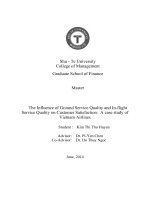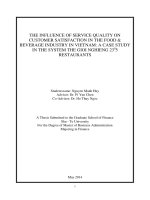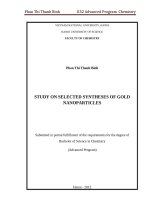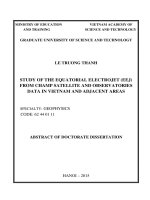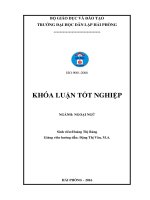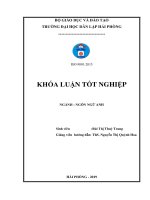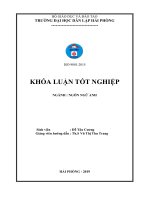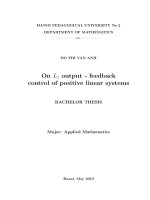Study on characterizations of chalcone synthae (chs) gene from pueraria lobata and pueraria mirifica in vietnam (khóa luận tốt nghiệp)
Bạn đang xem bản rút gọn của tài liệu. Xem và tải ngay bản đầy đủ của tài liệu tại đây (1.52 MB, 53 trang )
VIETNAM NATIONAL UNIVERSITY OF AGRICULTURE
FACULTY OF BIOTECHNOLOGY
UNDERGRADUATE THESIS
TITLE
STUDY ON CHARACTERIZATIONS OF CHALCONE
SYNTHAE (CHS) GENE FROM Pueraria lobata AND
Pueraria mirifica IN VIETNAM
Hanoi – 2021
VIETNAM NATIONAL UNIVERSITY OF AGRICULTURE
FACULTY OF BIOTECHNOLOGY
UNDERGRADUATE THESIS
TITLE
STUDY ON CHARACTERIZATIONS OF CHALCONE
SYNTHAE (CHS) GENE FROM Pueraria lobata AND
Pueraria mirifica IN VIETNAM
STUDENT:
Nguyen Minh Phuong
MAJOR:
Biotechnology
SUPERVISORS:
Huynh Thi Thu Hue, PhD.
Vietnam Academy of Science and Technology
Tran Thi Hong Hanh, M.S.
Vietnam National University of Agriculture
Hanoi – 2021
COMMITMENT
I hereby declare that I am the author of this thesis. This thesis is original and is
result of my own work.
This research is carried out without materials previously published or written by
another person except where due reference has been made in the text.
I acknowledge that the copyright of all literature cited in my thesis resides with
the copyright holders of that material is indicated the origin and all help is thankful.
I bear full responsibility for these reassurances.
Hanoi, February 1st , 2021
Student
Nguyen Minh Phuong
i
ACKNOWLEDGMENTS
This thesis would not have been possible if not for the help and support of many
people.
First and foremost, I would like to express my appreciation to my principal
supervisor, PhD. Huynh Thi Thu Hue, who has directly guided and dedicated to
supporting me in six months doing experiments, especially in writing this thesis. My
sincere thanks also go to MSc. Tran Thi Hong Hanh for her assistance and giving me
useful advice to complete this thesis.
In addition, I sincerely thank the principal of Vietnam National University of
Agriculture, Faculty board, and teachers in the Faculty of Biotechnology for providing
an active learning environment, as well as knowledge, and skills throughout four and a
half academic years.
I want to thank Assoc. Prof. Nguyen Xuan Canh and Dr. Dinh Truong Son, who
helped me to complete administrative procedures, introduced me to a new scientific
work environment.
Last but not least, special thanks go to all researchers at the Laboratory of
Genetic Biodiversity, Institute of Genome Research, Vietnam Academy of Science
and Technology (VAST) who supported me in the laboratory.
Student
Nguyen Minh Phuong
ii
TABLE OF CONTENTS
COMMITMENT ........................................................................................................... i
ACKNOWLEDGMENTS ............................................................................................ ii
TABLE OF CONTENTS ............................................................................................ iii
LIST OF TABLES........................................................................................................ v
LIST OF FIGURES ..................................................................................................... vi
LIST OF ABBREVIATIONS .................................................................................... vii
ABSTRACT ................................................................................................................ ix
CHAPTER I. INTRODUCTION ................................................................................. 1
1.1.
Introduction ...................................................................................................... 1
1.2.
Objectives ......................................................................................................... 2
CHAPTER II. LITERATURE REVIEW ..................................................................... 3
2.1.
Overview of the P.lobata and P.mirifica ......................................................... 3
2.1.1. General introduction of the P.lobata and P.mirifica........................................ 3
2.1.2. Biological characteristics of Pueraria plants ................................................... 4
2.2.
Application of P.lobata and P.mirifica ............................................................ 7
2.3.
Primary result and publications related to thesis ............................................. 8
2.4.
CHS gene encoding Chalcone synthase ........................................................... 9
2.4.1. Chalcone structure and biological activites ..................................................... 9
2.4.2. CHS gene encoding Chalcone synthase ........................................................... 9
CHAPTER III. MATERIALS AND METHODS ...................................................... 12
3.1.
Time and place of study ................................................................................. 12
3.2.
Materials ......................................................................................................... 12
3.2.1. Materials ......................................................................................................... 12
3.2.2. Chemical reagents .......................................................................................... 12
3.2.3. Equipment ...................................................................................................... 12
3.2.
Methods .......................................................................................................... 13
3.2.1. Total RNA extraction ..................................................................................... 13
3.2.2. Total RNA gel electrophoresis ....................................................................... 14
iii
3.2.3. cDNA synthesis .............................................................................................. 14
3.2.4. Amplification P.lobata and P.mirifica CHS genes by using RT-PCR .......... 16
3.2.5. RT-PCR products purification ....................................................................... 17
3.2.6. Sanger DNA sequencing ................................................................................ 18
CHAPTER IV. RESULTS AND DISCUSSIONS ..................................................... 19
4.1.
Total RNA extraction ..................................................................................... 19
4.2.
Amplification CHS genes by using RT-PCR ................................................. 20
4.3.
Purification of PCR products ......................................................................... 21
4.4.
Sequence analysis of P.lobata and P.mirifica CHS gene .............................. 22
4.4.1. Sequence analysis of P.lobata CHS gene ...................................................... 22
4.4.2. Sequence analysis of P.mirifica CHS gene and published CHS gene on
NCBI .............................................................................................................. 25
4.4.3. Nucleotide and amino acid sequence comparisons of isolated P.lobata and
P.mirifica CHS gene ...................................................................................... 28
4.4.4. Putative amino acid sequence analysis of CHS (P.lobata and P.mirifica) .... 32
CHAPTER V. CONCLUSION AND SUGGESTION .............................................. 37
5.1.
Conclusion ..................................................................................................... 37
5.2.
Suggestion ...................................................................................................... 37
REFERENCES ........................................................................................................... 38
iv
LIST OF TABLES
Table 3.1. Equipment used in the thesis ........................................................................ 13
Table 3.2. Components of cDNA synthesis .................................................................. 15
Table 3.3. Components of cDNA synthesis (continue) ................................................. 15
Table 3.4. Temperature and time for cDNA synthesis .................................................. 15
Table 3.5. Nucleotide sequence of primer for RT-PCR ................................................ 16
Table 3.6. RT-PCR reaction .......................................................................................... 16
Table 4.1. Quantitation of total RNA ............................................................................ 20
Table 4.2. Number of nucleotide differences in P.mirifica CHS gene and reference
on NCBI (JQ409456.1). .............................................................................. 28
Table 4.3. Number of different nucleotides between P.lobata and P.mirifica CHS
gene .............................................................................................................. 32
v
LIST OF FIGURES
Figure 2.1. Overall reaction of Chalcone ..................................................................... 10
Figure 2.2. Flavonoid biosynthetic pathway ................................................................. 11
Figure 3.1. RT-PCR program ........................................................................................ 17
Figure 4.1. Agarose gel electrophoresis of total RNA from P.lobata and P.mirifica ... 19
Figure 4.2. Agarose gel electrophoresis of CHS gene products .................................... 20
Figure 4.3. Agarose gel electrophoresis of purified PCR products ............................... 21
Figure 4.4. Sequence alignment of isolated P.lobata CHS gene and reference on
NCBI (D10223.1) ........................................................................................ 24
Figure 4.5. Sequence alignment of isolated P.mirifica CHS gene and reference on
NCBI (JQ409456.1). ................................................................................... 27
Figure 4.6. Pairwise alignment of P.lobata and P.mirifica CHS gene at nucleotide
and amino acid levels. ................................................................................. 31
Figure 4.7. Putative amino acid sequence alignment of the two isolated genes and
CHS protein of the five most significant similarity species in Fabaceae
family with full-length coding sequence ..................................................... 33
Figure 4.8. Multiple alignments of specific amino acid region of P.lobata ,
P.mirifica and other species in Fabaceae family. ....................................... 35
vi
LIST OF ABBREVIATIONS
Abbreviations
Definitions
aa
Amino acid
AD
Anmo Domini
BC
Before Christ
BLAST
Basic Local Alignment Search Tool
bp
Base pair
C164
Cysteine-164
cDNA
Complementery DNA
DEPC
Diethylpyrocarbonate
DNA
Deoxyribonucleic acid
dNTPs
Deoxynucleotide triphosphates
F215
Phenylalanine-215
G372
Glycine-372
H303
Histidine-303
K55, and K62
Lysine-55, Lysine-62
R58
Arginine-58
kb
kilobase
kDa
kilodaltons
L310, L317, L319 , L331
Leucine-310, Leucine-317, Leucine-319, Leucine-331
M
Molar
MCF-7
Michigan Cancer Foundation-7
mL
Milliliter
vii
mM
Milimolar
min
Minute
N336
Asparagine-336
ng
Nanogram
NCBI
National Center for Biotechnology Information
nm
Nanometer
P375
Proline-375
pT7-7
Plasmid pT7-7
rCHS
Recombinant Chalcone synthase
RNA
Ribonucleic acid
RNAase
Ribbonuclease
rpm
Revolutions per minute
rRNA
Ribosomal RNA
RT-PCR
Reverse Transcription -Polymerase Chain Reaction
S (28S, 18S, 5S)
Svedberg
UK
The United Kingdom
µL
Microlitre
US
The United States
VAST
Vietnam Academy of Science and Technology
viii
ABSTRACT
Pueraria genus (Pueraria lobata and Pueraria mirifica) is widely used as
a traditional medicinal herb. It is very useful for multi-purpose and functions
because of its high bioactivities accumulation. Many genes have significantly
demonstrated their respective roles in the biosynthetic pathways but little
information of chalcone synthase gene on both species is known in Vietnam.
The purpose of this research is to support more understanding about CHS genes
such as determining and sequence analyzing gene encoding CHS gene isolated
from P.lobata and P.mirifica. The full-length open reading frame (ORF)
sequence encoding CHS is identified with 1170bp and encoded 389 deduced
amino acids from P.lobata and P.mirifica by Sanger sequencing. The CHS gene
of P.lobata has no difference compared with CHS sequence reported on
GenBank (D10223.1), whereas a difference of 26 nucleotide positions in CHS
sequence was compared with the published gene sequence (JQ409456.1) as
consequential having 97.78% genetic similarity. The CHS gene of P.lobata and
P.mirifica have 19 nucleotide differences with 98.4% in genetic similarity.
Chalcone –stilbene synthase N-C terminal, PLN03173, CHS-like, BH0617,
fabH are some important domains predicted in isolated CHS gene. Especially,
the family signature „GVLFGFGPGLTI‟ of CHS gene as a part of the active-site
scaffold contributes to decide the product of cyclization reactions performing
the stereochemistry of cyclization and it appears in P.lobata and P.mirifica of
Pueraria genus, but is not in all Fabaceae family.
ix
CHAPTER I. INTRODUCTION
1.1. Introduction
Pueraria plants are traditional plants used in medicine since ancient times.
P.lobata seems to be one of the earliest species listed in traditional Chinese medicine
(Keung et al., 1998). The vast majority of Asian countries applied dried P.lobata roots
as an important ingredient of medicinal tea to treat influenza fever, dysentery and its
starch is also used for food and drink. Moreover, P.lobata root powder was used as a
single ingredient or in combination with other herbs such as Ginkgo biloba, Salvia
miltiorrhiza, Bacopa monnieri, Silybum marianum, and Salix alba in some countries
(the US, the UK, and Australia) for relieving hangover symptoms, improving liver
functions, aiding weight loss, fever and flu purposes since these products has
negligible side effects (Healthstore, 2011; TGA, 2011; Cheung et al., 2012)
P.mirifica has long been used and became a commercially crucial indigenous
medicinal plant in Thailand mainly because it has strong rejuvenating properties or
antioxidant activities for beauty benefits in pre and postmenopausal women.
Furthermore, the purposes are similar to modern hormone replacement therapy, good
effects on reproductive organs, breast size enhancement, support for the bone, hair,
and many other special functions (Wanadorn et al., 1933; Manonai et al., 2000;
Cherdshewasart et al., 2007). In Vietnam, P.lobata is mostly used as a summer
beverage, nutritional food as well as herbal remedy to treat diarrhea, muscle stiffness,
thirst, and diabetes. Currently, both roots and flowers of P.mirifica are used as a
dietary supplement for women because of their rich source of phytochemicals and
nutrition. Nevertheless, these products are considered to be less popular and advanced
in Vietnamese market than in other countries.
P. lobata and P.mirifica are known for their (iso)flavonoid accumulation at a
high level. As such, biological activities, the therapeutic potential of (iso)flavonoid,
and their health benefits have been confirmed by many previous studies.
(Iso)flavonoids play a pivotal role in the functions of plants as well as in human
health. In particular, there have been numerous reports on conducted researches of
CHS gene that participate in many important biosynthesis pathways in P.lobata and
P.mirifica: antioxidant, antimutagenic, antiproliferative activities, estrogen-like
1
activity, etc (Birt et al., 2001; Miadokova et al., 2002; Ryan-Borchers et al., 2006;
Iwasaki et al., 2008; Scarpato et al., 2008). These genes encoded Chalcone synthase,
which is part of secondary metabolite biosynthesis and is involved directly in the
pathway of (iso)flavonoid biosynthesis. It is being studied for its medicinal properties.
Especially, CHS is considered a key enzyme in many biosynthetic pathways, hence
studying this gene is a priority issue to well-understand the whole pathway. Moreover,
in Vietnam, the knowledge of biosynthesis metabolism and the characterization of
CHS gene from P.lobata and P.mirifica in such a pathway remains largely unknown.
=> As a consequence, we decide to choose the subject: “Study on the
characterizations of Chalcone synthase (CHS) gene from P. lobata and P. mirifica
in Vietnam‟‟
1.2. Objectives
Purpose: The objective of this research is to determine and sequence analyze gene
encoding for isolated CHS gene from P.lobata and P.mirifica for cloning and bacterial
expression purpose.
Requirements:
-Total RNA is extracted in a pure and less degraded form.
-The annealing temperature is optimized and utilized for specific amplification by
Reverse Transcriptase Polymerase Chain reaction (RT-PCR).
-Sanger sequencing is used to determine the sequence of nucleotide bases of DNA.
-Using bioinformatics tools is to compare, align, and analyze CHS genes and reference
on NCBI.
2
CHAPTER II. LITERATURE REVIEW
2.1. Overview of the P.lobata and P.mirifica
2.1.1. General introduction of the P.lobata and P.mirifica
Pueraria plants are classified in the scientific classification below:
Classification
Kingdom
Plantae
Order
Fabales
Family
Fabaceae
Subfamily
Faboideae
Tribe
Phaseoleae
Subtribe
Glycininae
Genus
Pueraria
P. lobata and P. mirifica are members of the genus Pueraria which belongs in
the subtribe Glycininae of the tribe Phaseoleae in the subfamily Faboideae of the
Leguminosae or Fabaceae family. Up to now, 26 native species have discovered in the
Pueraria genus all over the world, namely P.alopecuroides, P.bella, P.bouffordii,
P.calycina, P.candollei, P.mirifica, P.edulis, P.garhwarensis, P.imbricata, P.lacei,
P.maclurei,
P.montana,
P.chinensis,
P.lobata,
P.thomsonii,
P.peduncularis,
P.phaseoloides, P.javanica, P.subspicata, P.pulcherrima, P.sikimensis, P.stracheyi,
P.stricta, P.tuberosa, P.wallichii, P.xyzhuii (Wang et al., 2020).
The genus Pueraria is mostly distributed in Asia, parts of Oceania, the United
States, less abundant in southern Europe. The earliest Chinese written reference of the
use of kudzu (P.lobata) is described in the Classic of Poetry dated between 1000 BC
and 500 BC before being used as a medicinal herb in 206 BC–8 AD. Additionally,
P.lobata was included in the Japanese pharmacopeia during the Edo period (AD 1600–
1867) and was then known in the United States at the Japanese pavilion in
Philadelphia by 1876. Also, P.lobata was introduced to India from the United States in
1925–1926 (Bodner et al., 2002).
P.mirifica is a plant that grows in Asia (Thailand, Burma, Bangladesh and parts
of India), particularly Thailand around the northern hill town of Chiengmai which
3
have been weathered to a sandy or gravelly texture by the summer monsoon rains and
where, for many years, tuberous roots have been used in large quantities for processing
into various traditional Thai medicines (Ingham et al., 2002)
In Vietnam, Pueraria genus now has a total of 5 species which are cultivated
from mountains to plains. These plants grow naturally in Northwest Vietnam, and
primarily used for food and traditional medicine to treat some diseases: common colds,
fever, and diabetes. According to a major pharmaceutical company in Lang Son
province, north-east Viet Nam, the quantities of P.lobata
(cultivated
and
import)
reportedly traded in 2001 and 2002 with 2.0 and 2.5 tones, respectively. And, powder
extracts from P.lobata were high potentially exported to foreign: China, American,
HongKong, German (Van et al., 2008)
On the other hand, no articles mentioned the period of the first discovery of
Pueraria species in Vietnam, and knowledge about these species has remained limited.
2.1.2. Biological characteristics of Pueraria plants
In genus Pueraria, chromosome counts of P.lobata, P. phaseoloides and P.collettii
have been reported, with 2n=22, 2n=24, 2n = 20 or 4n = 44, while chromosome counts
of P.mirifica are unknown (van der Maesen, 2002)
2.1.2.1. Morphology
Members of the genus Pueraria are climbing, semi-woody, and perennial vines, with
hairy rusty-brown stems. The detailed characteristics of these plants are listed below:
Stem: Herbaceous, the outermost tissue is the epidermis (not bark), which is covered
by a waxy cuticle, hairy on the surface stem.
Leaf: Trifoliate leaves, a compound leaf has three leaflets arranged alternately along
the stem on a common stalk, and more than one abscission zone. Each leaflet is
divided into 2-3 lobed hairy margins and the leaf blade length and width are 7-16 cm
and 5-12 cm, respectively.
Flowers: Flowers are raceme inflorescence and pink to purple, fragrant, about 1.3cm,
produced in long racemes, and irregular in shape. They are born in long hanging
panicles at nodes on the stems.
4
Fruit: is the fruit type of the Fabaceae originates from one carpel, which splits along
two lines. Fruits are pale brown, flattened; hairy seedpods containing 3-10 reddishbrown (about 5 cm long), ovoid to ellipsoid, slightly flattened seeds.
Root: Roots are modified to tuberous, up to 17.8 cm in diameter. Roots typically reach
a depth of 1-3 m and are capable of storing large amounts of carbohydrates. The
taproot is extended and beneficial in that it supports the plant in surviving during
drought periods (Gulizia et al., 2019).
2.1.2.2. Physiological and ecological characteristics of P. lobata and P.mirifica
According to the Southeast Exotic Pest Plant Council, the genus Pueraria is
able to grow and develop well under various environmental conditions. Actually, the
greatest growth of P.lobata and P.mirifica occurs in mild winters (40-60°F), summer
temperatures increase over 80°F, and annual precipitation is large. Soil is an important
factor that helps P.lobata and P.mirifica to grow, but the optimal soil type is a deep,
loamy soil with pH 5.0 to 7.1 (Bodner et al., 2002; Gulizia et al., 2019). There is no
doubt that light availability strongly affects the genus Pueraria and all the plants
existing on the Earth. These observations are demonstrated by a review of Gulizia,
using indirect sunlight causes the growth rate to increase 3‐ fold comparing to shade,
and climbing trees which enhance the photosynthetic competition for light. Because of
surviving in fairly dry climates and drought conditions, P.lobata seem to be a droughttolerant plant having means for high yields.
2.1.2.3. Growth and development of P.lobata and P.mirifica
Members of Pueraria genus can be propagated from seed, cuttings, or crowns.
Seeds planted in spring usually develop four to six true leaves and at least one root
approximately 1.3 cm in diameter, 15 cm in length in four months, up to a length of 14
m in one year (Duke et al., 1981). During the growth new plants are established at the
nodes where vines are in contact with the soil. Roots of the new plants enlarge and
form new crowns supporting three to five vines. Young and one to two-year-old vines
are about 1.3 cm to 2.5 cm in diameter, while older vines can achieve 10 cm or more
across. After the second growing season, the vine connecting the crowns of the old and
new plants dies, with each crown producing new vines the next year (Dickens et al.,
1974). Individual roots swell and form large fleshy tuberous structures in which starch
5
is stored over the winter to support plant growth in spring. Such roots range from 3.8
cm to 18 cm in diameter for young vines and 2.5-3 m in length for older vines.
Surprisingly, the production of flowers and seeds of P.lobata does not appear until the
late summer and early fall of the third year, and these plants are cross-pollinated by
bees (Parks et al., 2002; Bodner et al., 2002).
2.1.2.4. Major chemical consistent of P.lobata and P.mirifica tuberous root
Pueraria plants, which are well known as oriental herbal medicines, are rich
sources of polyphenols (or phenolic compounds) and polyphenolic glycosides such as
isoflavonoids, isoflavonoid glycosides, coumarins, puerarols, 2-butenolides, and their
derivatives, which are by-products of the secondary metabolism of plants. Other
prominent chemicals also detected include triterpenoids and triterpenoid glycosides.
However, isoflavones and their glycosides are the major constituents (Rong et al.,
2002). Up to now, many new chemicals in Pueraria plants have been studied for
bioactivities and functions.
Moreover, P.lobata tuberous root includes isoflavonoids, polysaccharides,
saponins, alkaloids, etc. Among them, isoflavonoids contain puerarin, daidzein,
daidzin, genistein, coumestrol, and formononetin, which are famous for many
important biological activities for health benefits (Mun et al., 2015). P.mirifica
tuberous root mainly consist of isoflavonoids such as isoflavones, daidzein, genistein,
daidzin, genistin, kwakhurin, puerarin, and miroestrol, deoxymiroestrol, and related
compounds. The discovery of miroestrol and its precursor deoxymiroestrol compounds
is a key factor for further studies because of its highest estrogenic activity (Ingham et
al., 2002; Suntichaikamolkul et al., 2019; Kraithong et al., 2020).
6
2.2. Application of P.lobata and P.mirifica
Application in food
Pueraria plants, especially P.lobata, are widely spread over Asian countries
and have been introduced to New Guineea and New Caledonia and became the main
crop which is a staple food before yams (Dioscorea spp) and sweet potatoes (Ipomoea
batatas) (van der Maesen, 2002). Interestingly, almost all parts of P.lobata could be
used for food, for example, leaves, buds, and sprouts consumed as vegetables in
Korea, and their tuberous roots have been used as a source of starch, which is an
essential ingredient for cooking in Japan and Vietnam (Kayano et al., 2012).
P.lobata and P.mirifica in medicine
P.lobata has become a popular herbal plant in traditional medicine for two main
parts: the root and the flower. The first application of P.lobata root is in relieving
fever, common cold, diarrhea, headache, emesis and it also appears in a decoction as
the main component for curing neck stiffness, lack of perspiration in the classic
medical book in 200 AD. It was applied to treat alcohol-related problems such as an
anti-intoxication agent and an anti-dipsotropic agent (Bodner et al., 2002). Moreover,
P.lobata is also used as a potential dietary supplement to support anti-diabetic activity
and prevent inflammatory or oxidation-related diseases (Lertpatipanpong et al., 2020;
Yang et al., 2019; Ahn et al., 2019).
To date, P.mirifica is synthesized in pills, sprays, powdered forms, and extracts
so that it can be put in other medicinal preparations or herbs for smoothing the skin,
promoting hair growth, fingernails, improving appetite, supporting memory, and
providing relief for ailments like osteoporosis and even cancer in many countries,
including the US and Japan (Kakehashi et al., 2016). Both roots and flowers of
P.mirifica are currently utilized as a dietary supplement and functional food because it
is a rich source of phytochemicals and nutrition, especially, rejuvenating effects and
treatment for the symptoms related to estrogen deficiency in menopausal women as
well as in andropausal men, and enhancing breast size are mentioned. However, the
optimal doses for each desirable effect and the balance to avoid undesired side effects
need to be calculated before use (Malaivijitnond et al., 2012). Miroestrol of P.mirifica
tuberous roots as endogenous estrogen was produced from the oxidation of
7
deoxymiroestrol which enhances the effects of toremifene on MCF-7 human breast
cancer cells (Peerakam et al., 2018).
Cosmetics
Recently, P.mirifica or P.lobata extracts were added to formulated cosmetic
products applying for women‟s health and beauty aids (Cherdshewasart et al., 2009).
For instance, cosmetic products from P.mirifica extracts have been prepared in serum
and lotion such as breast enhancement cream, eye gel, and skin lotion (Malaivijitnond
S, 2012). Surprisingly, P.lobata also has potential biological activities that need to be
discovered more for future cosmetic application such as antioxidative activity,
antiglycation activity, melanogenesis inhibitory activity, skin regeneration activity
(Bebrevska et al.,2010; Gasser et al.,2011; Kim et al., 2015).
2.3. Primary result and publications related to thesis
Globally, there have been many studies on CHS genes for P. lobata and
P.mirifica. The chalcone synthase superfamily of type III polyketide synthases (Austin
et al., 2003) are primary enzymes that also participate in many important biosynthesis
pathways, especially isoflavonoids for some prominent roles: antiangiogenic,
antitumor activities, and estrogen-like activity (Mun et al.,2015) Chalcone synthase is
a pivotal and first enzyme in the (iso)flavonoid biosynthesis process in plants.
Moreover, a series of studies on the characterization of Chalcone synthase gene has
been published on buckwheat (Fagopyrum esculentum M), Phaseolus vulgaris, and
Hordeum vulgare (Hrazdina et al., 1986; Ryder et al., 1987; Rohde et al., 1991).
Because of its characteristics, chalcone synthase cDNAs in Petunia hybrid, soybean,
Pisum sativum are carried out for molecular cloning with different research purposes,
and fields (Shao et al., 1995, Estabrook et al., 1991, Ichinose et al., 1992). Especially,
cDNA was taken from the cultured cells of P.lobata for isolation and sequencing.
Lastly, the full length of cDNA with 1170bp encoding 390aa was cloned to
Escherichia coli expression vector pT7-7 (Nakajima et al., 1991, Nakajima et al.,
1996) and the expression of chalcone synthase was found mostly in roots compared to
other parts of the plant (Korsangruang et al., 2010).
8
Furthermore, Dao and her colleagues further studied chalcone synthase to
continue with its characteristics in plant resistance following many previous articles in
2011 (Dao et al., 2011).
The characteristics of CHS gene in Pueraria plants or related studies have not
been popularly known in Vietnam. Remarkably, Pham Van Hung and others carried
out research in Japan to determine chemical compositions, isoflavone compounds, fine
structure, and physicochemical properties of commercial Pueraria lobata starches
from Vietnam, which is the one and only research of Vietnam Pueraria plants.
2.4. CHS gene encoding Chalcone synthase
2.4.1. Chalcone structure and biological activites
Chalcones are widely known as a α,β-unsaturated ketones includinng of two
aromatic rings that linked by an aliphatic three-carbon chain having diverse array of
substituents. And, the two rings of chalcone are interconnected by a highly
electrophilic three-carbon α,β-unsaturated carbonyl system that assumes linear or
nearly planar structure. They possess conjugated double bonds and a completely
delocalized π-electron system on both the aromatic rings (Figure 2.1).
In terms of biological activites, chalcones drivatives for different biological
activities such as including antimicrobial, anticancer, antitubercular, antioxidant, antiflammatory, enzyme inhibitory, etc, with the growing interest of synthetic organic,
pharmacological, and medicinal chemists will be developed in the future (Tekale et al.,
2020).
2.4.2. CHS gene encoding Chalcone synthase
Chalcone synthase is a condensing enzyme, unique to plants that is discovered
and selected to study in many higher plants. Therefore, researchers were interested in
studying CHS gene encoding Chalcone syn thase.
By the end of the 19th century, P.lobata CHS gene was predicted to encode a
43kDa protein having 6-7 isoforms by Nakajima and others (Nakajima et al., 1991).
The full-length open reading frame of CHS gene was also obtained from Pueraria
candollei var. mirifica, with 1170 bp in length encoding for 389 amino acid residues
with a relative molecular mass of 42.6 kDa (Wiriyaampaiwong et al., 2012).
9
In general, chalcone is created by the sequential condensation of one pcoumaroyl and three malonyl-coenzyme A (CoA) molecules which are catalyzed by
chalcone synthase through a chain of reactions such as decarboxylation, condensation,
and cyclization (Figure 2.1).
Figure 2.1. Overall reaction of Chalcone (Ferrer et al., 1999)
Regarding biosynthetic pathway, the role of chalcone synthase is noted to be
the most important factor, particularly in flavonoid and isoflavonoid, catalyzing the
first committed step as a „gatekeeper‟ in the process (Figure 2.2). Flavonoids are
performed via the phenylpropanoid and polyketide pathway releasing a chalcone or
naringenin chalcone (Figure 2.1) by enzyme chalcone synthase (CHS). Starting with
the first substrate, phenylalanine is removed amides to produce cinnamic acid that is
hydroxylated to produce p-coumarate by using cinnamate 4-hydroxylase. p-coumarate
is then activated by enzyme 4-coumarate-CoA ligase attaching a coenzyme A (CoA),
and subsequently, a chalcone skeleton is formed between chalcone synthase (CHS)
and p-coumaroyl-CoA to three molecules of malonyl-CoA. The chalcone is isomerized
to a flavanone by the enzyme chalcone flavanone isomerase (CHI). From this central
point, the pathway divides into several branches, releasing a different class of
flavonoids. After that, flavanone 3-hydroxylase (F3H) catalyzes the stereospecific 3ßhydroxylation of (2S)-flavanones to dihydroflavonols. For the biosynthesis of
anthocyanins,
the
reduction
of
dihydroflavonols
to
flavan-3,4-diols
(leucoanthocyanins) is catalyzed by dihydroflavonol 4-reductase (DFR). Converting to
anthocyanidins is next carried out by anthocyanidin synthase (ANS) and subsequently,
the formation of glucosides is catalyzed by UDP glucose-flavonoid 3-O-glucosyl
transferase (UFGT), which stabilizes the anthocyanidins by 3-O-glycosilation.
10
Figure 2.2. Flavonoid biosynthetic pathway
ANS anthocyanidin synthase; AS aureusidin synthase; C4H cinnamate-4-hydroxylase;
CHR chalcone reductase; DFR dihydroflavonol 4-reductase; DMID 7,2’- dihydroxy,
4’- methoxyisoflavanol dehydratase; F3H flavanone 3-hydroxylase; F3’H flavonoid 3’
hydroxylase; F3’5’H flavonoid 3’5’ hydroxylase; FS1/FS2 flavone synthase; I2’H
isoflavone 2’-hydroxylase; IFR isoflavone reductase; IFS isoflavone synthase; IOMT
isoflavone
O-methyltransferase;
LCR
leucoanthocyanidin
reductase;
LDOX
leucoanthocyanidin dioxygenase; OMT O-methyltransferase; PAL phenylalanine
ammonialyase; RT rhamnosyl transferase; UFGT UDP flavonoid glucosyl
transferase; VR vestitone reductase; STS stilbene synthase; FLS flavanol synthase
(Dao et al., 2011).
11
CHAPTER III. MATERIALS AND METHODS
3.1. Time and place of study
Time of study: The thesis was conducted from August to December, 2020
Place of study: All the experiments of this thesis were conducted in laboratory
of Genetic Biodiversity, Institute of Genome Research, Vietnam Academy of Science
and Technology (VAST).
3.2. Materials
3.2.1. Materials
+ Object: tubes of P. lobata (Thai Nguyen) and P.mirifica (Nghe An)
3.2.2. Chemical reagents
-Total RNA extraction chemicals: TRIzol reagents, chloroform, 2-propanol, 70%
ethanol, 100% ethanol, DEPC treated water.
-Total RNA electricphoresis chemicals: agarose, TAE 1X, 6X DNA loading dye,
EtBr solution (1%).
-DNA electrophoresis chemicals: agarose, TAE 1X, 6X DNA loading dye, EtBr
solution (1%).
-cDNA synthesis kit: First-Strand cDNA synthesis Kit for RT-PCR using Thermo
Fisher KIT (Revert Aid Reverse Transcriptase).
-RT-PCR
reaction:
DreamTaq
Polymerase,
DreamTaq
buffer,
dNTPs
(ThermoFisher).
-DNA purification Kit (OMEGA bio-tek).
-Sterile mortars and pestles.
-Pipettes and tips, 1.5 mL Eppendorf tubes, PCR tubes (0.2 mL).
-Other materials and reagents.
3.2.3. Equipment
All the types of equipment used during the process of doing the experiments
belong to the Institute of Genome Research - Vietnam Academy of Science and
Technology.
12
Table 3.1. Equipment used in the thesis
Equipment
Origin
Deep refrigerator -80oC, -20oC, 4oC
US
Analytical Balances
China
Memmert WNB22
German
Vacuum concentrator, Concentrator plus
Eppendorf, German
Speed Vortex Mixer
China
Eppendorf Centrifure 5424R
Eppendorf, German
UV PCR Master Cycler Pro S
Eppendorf, German
GEL electrophoresis power supply EPS 301
US
Gel Documentation System
US
NanoDrop™ One/OneCMicrovolume UV-Vis
US
Spectrophotometer with Wi-Fi
Class II Biological Safety Cabinet
Indonesia
3.2. Methods
3.2.1. Total RNA extraction
RNA was extracted by using TRIzol Reagent has been innovated appropriately
with P.lobata and P.mirifica tubes.
Step 1: Grind 1 gram sample to powder by a sterilised mortar and pestle in
nitrogen liquid.
Step 2: Add 1000 µL Trizol, gently mix, then transfer liquid into new
Eppendorf tube (1.5 mL) and keep at room temperature for 5 min.
Step 3: Centrigure at 12,000rpm, 4oC for 5 min. Transfer the supernatant into
new 1.5 mL Eppendorf tube.
Step 4: Add 300 µL Chloroform, vortex and centrifuge at 12,000rpm, 4oC for
15 min.
Step 5: Transfer carefully the supernatant into a fresh 1.5 mL Eppendorf tube.
Step 6: Add 300 µL of chilled 2-propanol. Store at -20oC for 1 hour to
precipitate total RNA.
Step 7: Centrifuge at 12,000 rpm, 4oC for 15 min. Discard the supernatant of
the 2-propanol without disturbing precipitate the RNA at the bottom of the tube. Add
13
300 µL Ethanol 70% to wash RNA. Centrifuge at 12,000 rpm, 4oC for 15 min and
decant ethanol.
Step 8: Air-dry the RNA pellet for 30 min at room temperature. Dissolve RNA
with 50µL DEPC-treated water.
Step 9: Check total RNA by using agarose gel electrophoresis (0.8%) and
estimate the concentration of RNA by measuring the absorbance at 260nm.
Step 10: Store total RNA at -80oC.
3.2.2. Total RNA gel electrophoresis
RNA is a single-stranded nucleic acid and the presence of self-complementary
sequences in the RNA strand has tendency to form bulges and helices through
intrachain interactions such as base-pairing and folding of the ribonucleotide chain.
Based on the size and integrity of RNA on agarose gel, the quality of RNA can be
evaluated. RNA forms different secondary structures that interfere with size-based
migration on the agarose gel. Before doing total RNA electrophoresis, it is necessary
to denature the RNAs so that they remain in the single strand state. Electrophoresis on
0.8% agarose gel was carried out for 30min with constant voltage (150 V), ampe 300A
and then gel stained with EtBr solution of 10 µg/mL (1%) for 3min and take pictures
with gel documentation system.
3.2.3. cDNA synthesis
Revert Aid Reverse Transcriptase KIT was used to synthesize the first-strand
cDNA from the total RNA and amplify the CHS gene, with the components and
thermal cycle steps in cDNA synthesis are designed and listed in Table 3.2, Table 3.3
and Table 3.4. Products are then stored at -20 oC to carry out the following
experiments.
14
